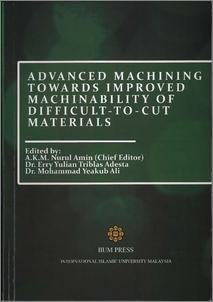Amin, A. K. M. Nurul and Dali, Mohd Hasani and Mahmud, Md. Asif
(2011)
High speed end milling of single crystal silicon using diamond coated tools.
In:
Advanced Machining Towards Improved Machinability of Difficult-to-Cut Materials.
IIUM Press, Kuala Lumpur, Malaysia, pp. 217-223.
ISBN 9789674181758
![[img]](http://irep.iium.edu.my/style/images/fileicons/application_pdf.png)  Preview |
|
PDF (High speed end milling of single crystal silicon using diamond coated tools)
- Published Version
Download (568kB)
| Preview
|
Abstract
Brittle materials are hard to machine while maintaining the surface roughness desired. A brittle
material will have little tendency to deform before it fractures when it is subjected to stress.
Brittle material is also consider as a material which fails in tension rather than shear and has little
or no evidence of plastic deformation before it fails. Thimmaiah et al. [1] specified that brittle
materials, silicon by their inherent properties, are difficult to machine while maintaining the
desired surface roughness but J. Yan et al. [2] reviewed that silicon is a nominally brittle material
that can be deformed plastically in machining, yielding ductile chips under the influence of high
hydrostatic pressure. Mariayyah [3] , stated that under certain controlled conditions, it is possible
to machine brittle materials in ductile regime so that material removal is by plastic deformation,
leaving a damage free surface. Rusnaldy et al. [4] research on the cutting parameters effect. They
study about the effect of the depth of cut, feed rate and spindle speed. Rusnaldy et al. [5] showed
that the dominant ductile cutting mode was achieved for Ft/Fc>1.0, which indicates that the
thrust force is dominant over the cutting force. Cutting to a very small uncut chip thickness can
cause ploughing, resulting in a poor surface due to high friction. Siva [6] proposes a predictive
model to determine the undeformed chip thickness in micro-machining of single crystal brittle
materials, where the mode of chip formation transitions from the ductile to the brittle regime.
The proposed model would support the determination of the cutting conditions for the micromachining
of a brittle material in ductile manner without resorting to trial and error.
Furthermore, Sreejith [7] was able to obtain ductile mode of machining on silicon nitride by
using Poly Crystalline Cubic Diamond (PCD) tools. His findings show that there is a maximum
value of rake angle which will obtain ductile mode machining. Thimmaiah et al. [1] also did
machining on silicon nitride but performed it using single point diamond turning. Their result
indicates that small values of feed, small tooltip radius and at high speeds; conditions of pressure
and temperature exist that facilitate ductile behaviour during machining. Negative rake angles
are more likely to cause brittle to ductile transition when compared with the positive or zero
degree rakes. These findings also correspond with Thimmaiah et al. [1] findings which also show
that cutting force and thrust force increases as the rake angle becomes negative. The
experimentation results differ with a crossover at between thrust force and cutting force at -45º.Furthermore, J. Yan et al (2000) stated that there is no inherent advantage in using rake angle
more negative than -40º.
Actions (login required)
 |
View Item |


 Download Statistics
Download Statistics Download Statistics
Download Statistics